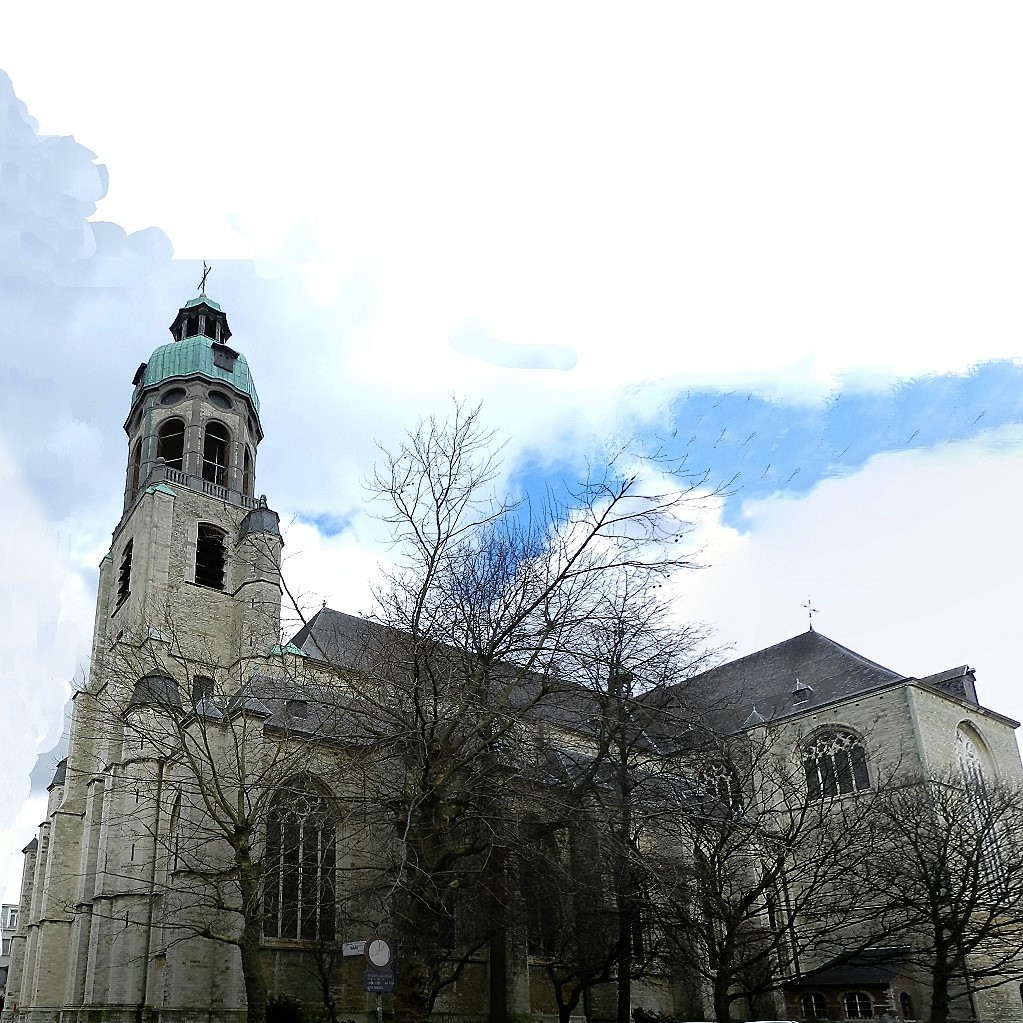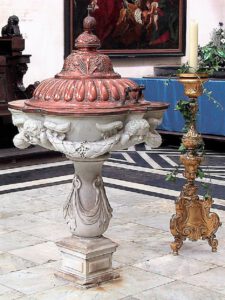Antwerp's St Andrew's Church, a revelation.
Choir and Chancel
Stained glass windows: Faith, Hope and Charity/Love
There is more consistency in the three stained glass windows of the chancel (by Jan Huet, 1964-1965) than is evident at first sight. Two personifications can be found high up: Faith (with cross) on the north side, Hope (with anchor) on the south side. The central apseSemi-circular or polygonal extension where the high altar is located in a church. window has been walled in. Where, then, might one find the principal one of the three theological virtues? Love resides closest to the altarThe altar is the central piece of furniture used in the Eucharist. Originally, an altar used to be a sacrificial table. This fits in with the theological view that Jesus sacrificed himself, through his death on the cross, to redeem mankind, as symbolically depicted in the painting “The Adoration of the Lamb” by the Van Eyck brothers. In modern times the altar is often described as “the table of the Lord”. Here the altar refers to the table at which Jesus and his disciples were seated at the institution of the Eucharist during the Last Supper. Just as Jesus and his disciples did then, the priest and the faithful gather around this table with bread and wine. and to the ground floor in the big stained glass window on the south side, above the corridor leading to the sacristyThe room where the priest(s), the prayer leader(s) and the altar server(s) and/or acolyte(s) prepare and change clothes for Mass.. Here, the glazier tells Jesus’ parable The Good Samaritan (Lk 10:29-37) in many hues and colours. Both Levite and priestIn the Roman Catholic Church, the priest is an unmarried man ordained as a priest by the bishop, which gives him the right to administer the six other sacraments: baptism, confirmation, confession, Eucharist, marriage, and the anointing of the sick. seek to avoid the wounded man – although he is a compatriot of theirs – and turn around inquisitively. They see how a third passer-by, a Samaritan in fact, cares for the victim and supports him on the way to the inn. What a wonderful illustration of Charity/Love!
Baptismal font
The current baptismal fontThe stone or metal vessel containing holy water, used for administering baptism. Often the baptismal font is/was located in a specially designed baptistery, usually close to the entrance of the church. is the holy waterWater that has been consecrated during the Easter vigil and which is used for baptisms and ritual blessings. fontA small basin at the entrance of a church, containing holy water so that the faithful may sprinkle themselves with it when entering the church, while making the sign of the cross, as a symbol of outward and inward cleansing. of a former monasteryComplex of buildings in which members of a religious order live together. They follow the rule of their founder. The oldest monastic orders are the Carthusians, Dominicans, Franciscans, and Augustinians [and their female counterparts]. Note: Benedictines, Premonstratensians, and Cistercians [and their female counterparts] live in abbeys; Jesuits in houses. church, probably of the Calced Carmelites (also known as the Order of the Brothers of the BlessedUsed of a person who has been beatified. Beatification precedes canonisation and means likewise that the Church recognises that this deceased person has lived a particularly righteous and faithful life. Like a saint, he/she may be venerated (not worshipped). Some beatified people are never canonised, usually because they have only a local significance. Virgin Mary of Mount Carmel) situated in Meir. Since its arrival at the church of St Andrew’s in 1806, the font had been in the back of the baptismal chapel
A small church that is not a parish church. It may be part of a larger entity such as a hospital, school, or an alms-house, or it may stand alone.
An enclosed part of a church with its own altar.
, at the south side. Among those who were baptised here, we may recognize several Belgian authors: Hendrik Conscience (baptised in 1812), the man ‘who taught his people to read’ because he was the first to write really popular books in Flemish, and the novelist Lode Zielens (baptised in 1901). During the 1880’s , baptismThrough this sacrament, a person becomes a member of the Church community of faith. The core of the event is a ritual washing, which is usually limited to sprinkling the head with water. Traditionally baptism is administered by a priest, but nowadays it is often also done by a deacon. was administered to more than a thousand new-borns on average per year, equalling around 2.5% of the population! Since the church’s restoration in 1970-1975, the font has been in the choirIn a church with a cruciform floor plan, the part of the church that lies on the side of the nave opposite to the transept. The main altar is in the choir.; this move echoes the teachings of the Second Vatican CouncilA large meeting of ecclesiastical office holders, mainly bishops, presided by the pope, to make decisions concerning faith, church customs, etc. A council is usually named after the place where it was held. Examples: the Council of Trent [1645-1653] and the Second Vatican Council [1962-1965], which is also the last council for the time being. (1962-1965), which focused on the community receiving the newly-baptised.
The adoration of the Magi

This painting is attributed to Hendrick van Balen (1573-1632), a contemporary of Rubens. Note the painter’s realism in depicting baby Jesus’s wish to play with everything that glitters, such as the bald head of the oldest king, who enters first and kneels down. The falconer on the far left illustrates the century-old royal privilege of falconry, as applied to these ‘three kings’. In line with Baroque tradition, the falconer leans against the frame and looks at the viewer – as does one of the page boys – thus engaging the audience in the scene. The colours of Mary’s dress have a symbolical significance: the red represents her as a woman of flesh and blood, the blue (green, rather, due to the varnish) as one chosen by divine grace.
The guardian angel

This canvas with rounded upper corners was painted by Erasmus Quellinus II (1667) and adorned the portico altar of the Brotherhood of the Holy Guardian Angels. The chapel was situated in the southern transeptThe transept forms, as it were, the crossbeam of the cruciform floor plan. The transept consists of two semi transepts, each of which protrudes from the nave on the left and right., which the churchwardens had demolished in 1830. A design sketch is kept in Dresden. A scared youth is seen crouching in the painting’s centre, caught in a moral dilemma. On one side, the boy’s virtue is being challenged by wicked, many-faced Evil, which is depicted as a demon with the wings of a bat, and is about to throw a snake onto his victim. A pleasant woman dressed in red and with one naked shoulder represents the erotic figure of Lust (Luxuria), grabbing the boy’s arm; she is supported by winged Amor, who is ready to shoot his arrow. Dressed elegantly in silvery blue, Lady Fortune is sitting on a treasure chest in the foreground. She embodies three temptations in one: pointing her sceptre at the riches in two bags of gold coins at her side, she further seduces the boy to accept fame – represented by the laurel wreath –and power – a golden royal crown. This particularly seductive trio sought to tempt Jesus in the desert too, and did so in vain (Matt 4:1-11).
On the other side, iconographically to the right, a ‘guardian’ angel armed with lightning fire approaches to protect the boy against these enemies of his soul’s salvation. The angel acts for God, whose identity is represented by the tetragram on the shield. Clearly, the angel is aware of God’s strengthening grace – note the beam of heavenly light falling on the angel’s shield.
With great effort, we may recognize the gaping monster at the bottom left depicting the entrance to hell, which is where the devil’s temptations seek to lead the boy. But this cunning offensive by the worldly vices will fail due to heavenly assistance, alias the guardian angel. This scene was rendered as an engraving and published in limited edition as a memorial picture for two distinguished brotherhood members.


